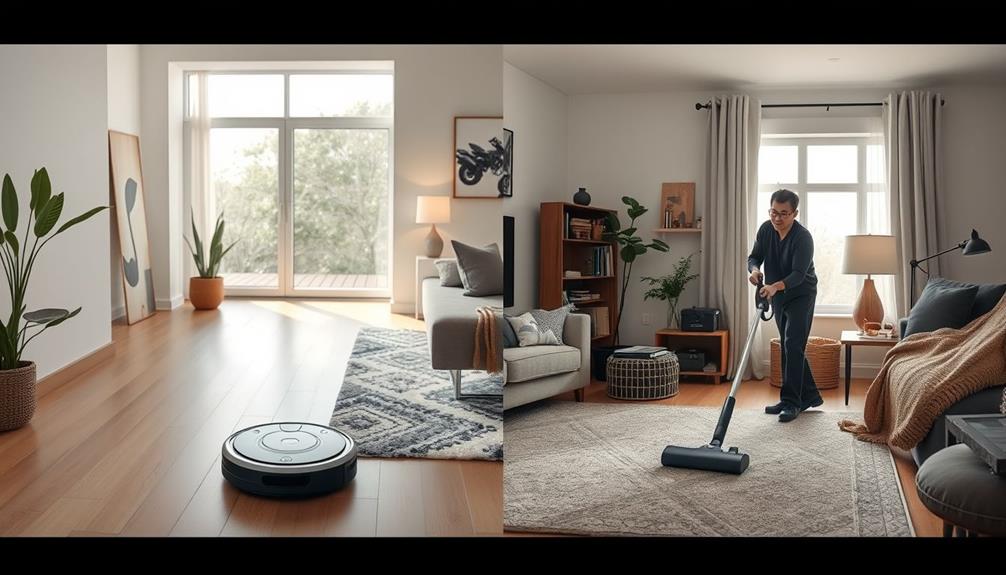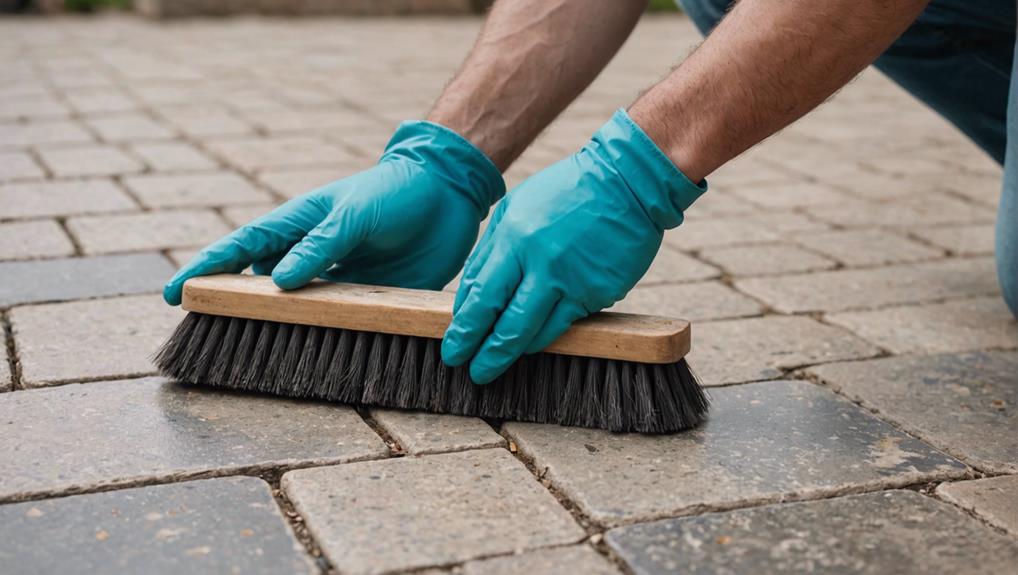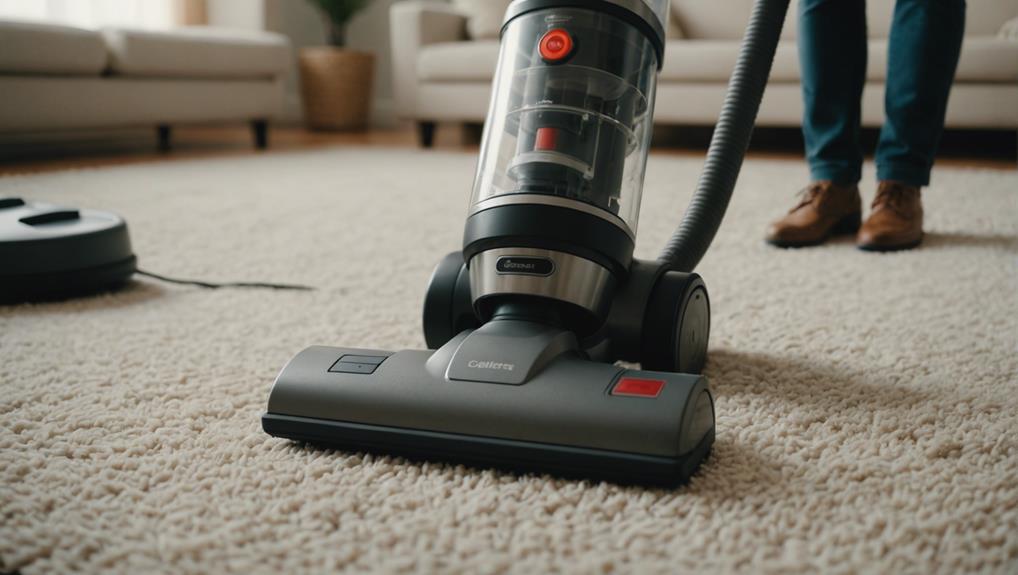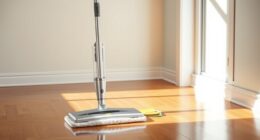When deciding between robot vacuums and traditional vacuums, consider your priorities. If you value convenience, robot vacuums can simplify your cleaning routine with their automatic functionality. On the other hand, traditional vacuums provide superior suction power, which is ideal for thorough cleaning, especially in frequently used areas. They also come equipped with larger dust bins and improved filtration systems for better air quality. If noise is a factor, robots tend to operate more quietly. Ultimately, your decision should align with your cleaning preferences and budget. Stay tuned; there is more to learn about how these choices compare in your home.
Key Takeaways
- Traditional vacuums provide superior suction power, ideal for deep cleaning carpets and removing heavy debris, while robot vacuums focus on convenience and surface cleaning.
- Robot vacuums excel in automated cleaning for uncluttered spaces, but require more frequent maintenance due to smaller dust bins.
- Traditional vacuums typically feature larger dust bins and HEPA filters, enhancing air quality by capturing more allergens and dirt.
- Cost-wise, traditional vacuums are generally more affordable upfront, while robot vacuums can be pricier but offer ongoing convenience.
- The choice between vacuum types should consider cleaning needs, space layout, and budget, balancing performance against convenience.
Overview of Vacuum Types
When it comes to keeping your home clean, understanding the different types of vacuums can make all the difference. Traditional vacuums come in four main types: upright, canister, stick, and handheld.
Upright vacuums are powerful, making them ideal for deep cleaning large carpeted areas. Canister vacuums offer excellent mobility and versatility, effectively cleaning both carpets and hard floors. For pet owners, specialized options like the Bissell Pet Hair Eraser Vacuum are designed to tackle stubborn pet hair with enhanced suction power.
If convenience is what you're after, stick vacuums are lightweight and often cordless, perfect for quick clean-ups. Handheld vacuums, on the other hand, are portable and excellent for spot cleaning small messes.
On the other side, robot vacuums have gained popularity, with various models available to suit different cleaning needs. Basic models handle simple tasks, while mid-range versions boast better navigation.
Advanced robot vacuums come packed with smart features, allowing for customizable cleaning paths. For thorough cleaning, hybrid robot vacuums combine vacuuming and mopping, particularly useful in homes with hard surfaces.
Knowing these types of vacuum cleaners helps you choose the right one for your home systems, ensuring you meet your unique cleaning needs effectively.
Key Features Comparison

When comparing robot vacuums and traditional vacuums, suction power and filtration systems play essential roles in their effectiveness.
You'll notice that traditional vacuums often deliver stronger suction for deep cleaning, making them ideal for tackling pet hair and dirt on carpets, especially with models designed for pet-friendly homes like those featuring anti-tangle technology.
While many robot vacuums focus on convenience with smart features, they can still be effective for quick clean-ups and maintenance.
Additionally, both types can offer HEPA filtration, but their designs and capabilities vary greatly.
Suction Power Differences
Suction power is a key differentiator between robot vacuums and traditional models, impacting their cleaning effectiveness. If you want to maintain a clean home, understanding these differences is essential.
Traditional vacuums generally offer superior suction power, making them more effective for deep cleaning carpets and tackling embedded dirt. In contrast, robot vacuums usually range from 600 to 2,500Pa, focusing primarily on light debris and surface cleaning.
Furthermore, using air purifiers to enhance indoor air quality can complement your vacuuming efforts by reducing allergens.
Here are three key points to take into account:
- Deep Cleaning: Traditional vacuums can remove over 50% of embedded debris in performance tests, while robot vacuums only achieve about 20%, highlighting a significant gap in effectiveness.
- Heavy Debris: If you have pets, traditional vacuums excel at picking up heavy pet hair and larger particles, where robot vacuums often struggle.
- Air Quality: While both types may feature HEPA filtration, traditional vacuums typically enhance air quality better by effectively trapping dust and allergens.
Ultimately, if suction power is your primary concern, especially for deep cleaning, traditional vacuums are your best bet for maintaining a clean, healthy home.
Filtration System Comparison
Typically, the filtration systems in robot vacuums and traditional vacuums differ greatly in design and effectiveness. Robot vacuums often come equipped with HEPA filtration systems that excel at trapping allergens and fine dust, enhancing your home's air quality. This is particularly beneficial for pet owners, as many cats can be sensitive to dust and allergens, leading to respiratory issues.
However, their smaller dust bins mean you'll need to empty them more frequently than traditional vacuums, which typically offer larger bags or bins that can handle extensive debris cat health and dietary considerations.
High-end robot models, like the DEEBOT N10 PLUS, feature advanced filtration options, such as E11 antibacterial filters, designed to capture smaller particles for better allergen reduction. While these systems improve cleaning performance, traditional vacuums usually outperform robots in maintaining air quality over larger areas. Their powerful motors and superior suction capabilities help extract deep-seated dust and allergens more effectively.
Ultimately, the effectiveness of a vacuum's filtration system can greatly impact your cleaning experience. If you suffer from allergies, you'll want to take into account both the HEPA filtration of robot vacuums and the robust options available in traditional vacuums, balancing convenience with performance and maintenance needs.
Pros and Cons Analysis

Choosing between robot vacuums and traditional vacuums means weighing the benefits and drawbacks of each option. You'll want to evaluate how these factors align with your cleaning needs.
1. Cleaning Convenience: Robot vacuums offer automated cleaning, letting you schedule sessions without lifting a finger. They're especially beneficial for busy households or those who prefer a hands-off approach to cleaning, making them a popular choice for many.
Traditional vacuums require manual operation, which can be time-consuming.
2. Suction Power: If deep cleaning is your priority, traditional vacuums excel with superior suction power, effectively tackling dirt embedded in carpets.
Robot vacuums may struggle in those situations, particularly in homes with pets or heavy foot traffic. What to look for in a home cleaning service can also inform your decision on which vacuum might suit your needs better.
3. Maintenance Costs: Traditional vacuums tend to have lower maintenance costs due to easy repairs and simple replacements.
In contrast, robot vacuums can incur higher repair costs because of their advanced technology.
Additionally, assess dust bin capacity and noise levels. Traditional vacuums usually have larger bins, meaning you'll empty them less often, while robot vacuums need frequent attention due to smaller bins.
On the noise front, robot vacuums operate at lower decibels, making them ideal for quieter environments, whereas traditional vacuums can be disruptive.
Weigh these pros and cons carefully to find the right fit for your home.
Cleaning Efficiency and Performance

When it comes to cleaning efficiency and performance, traditional vacuums greatly outshine their robotic counterparts. For instance, models like the Miele Dynamic U1 can pick up over 50% of embedded debris, while robotic vacuums like the Samsung Powerbot manage to collect less than 20%. This significant disparity highlights the deep cleaning performance that traditional vacuums offer, especially in high-traffic areas.
Additionally, just as a well-maintained heat pump operates efficiently, a traditional vacuum's performance is maximized through regular upkeep and proper use, ensuring ideal cleaning results heat pump efficiency.
Though robotic vacuums excel at maintaining cleanliness by effectively removing surface debris, they're best suited for daily upkeep rather than thorough cleaning. You may find that their internal dustbin capacity is comparable to a quart of milk, requiring more frequent emptying compared to the larger bins of traditional models.
While advanced robotic vacuums can autonomously map rooms and follow specific cleaning patterns, they often lack the thoroughness needed for deep cleaning tasks.
Consumer Reports consistently emphasizes that traditional vacuums outperform robotic models in overall cleaning efficiency, particularly on carpets and when dealing with extensive debris removal. If you value deep cleaning performance and thoroughness, you'll likely find traditional vacuums to be the superior choice for your home.
Cost and Budget Considerations

Investing in a vacuum cleaner means weighing the costs carefully, as traditional models generally offer a more budget-friendly option upfront.
While traditional vacuums range from $50 to $100, robot vacuums typically start at $150 and can go up to $500, especially for high-end models with advanced features.
When reflecting on your budget, keep these factors in mind:
- Upfront Costs: Traditional vacuums have lower initial prices, making them accessible for tight budgets. However, just like when evaluating potential Gold IRA providers, it's important to assess the long-term value of your investment in cleaning appliances.
- Maintenance: Although traditional vacuums can incur costs for replacement parts over time, robot vacuums might save you on manual cleaning effort, providing long-term value. Additionally, understanding the ongoing maintenance costs can help you avoid unforeseen expenses, similar to how one should manage risks in a Bitcoin IRA.
- Dust Bin Capacity: Traditional vacuums often have larger dust bins, requiring less frequent emptying, while robot vacuums need more regular maintenance due to smaller capacities.
Ultimately, the decision hinges on your cleaning needs and preferences.
If you value convenience and automation, a robot vacuum might be worth the investment.
However, if you're looking for efficient deep cleaning, especially in homes with extensive carpeting, a traditional vacuum could deliver better value within your budget.
Filtration Systems and Air Quality

When it comes to improving air quality, HEPA filters play an essential role in trapping allergens and fine dust.
While traditional vacuums often come equipped with these highly effective filters, some advanced robot vacuums also offer impressive filtration systems.
Choosing the right vacuum can impact not only cleanliness but also overall health, as diversification of retirement portfolio can parallel the need for a clean and safe living environment.
It's important to compare the filtration capabilities of both types to guarantee you're choosing the best option for your home.
Importance of HEPA Filters
HEPA filters' ability to capture at least 99.97% of particles as small as 0.3 microns makes them vital for maintaining healthy indoor air quality.
Whether you're using traditional vacuums or advanced robotic models, these filters help reduce allergens like pet dander, dust mites, and pollen in your home.
Additionally, mammography effectiveness in early detection greatly increases survival rates, highlighting the importance of understanding and managing health risks in your environment.
Here are three key benefits of using HEPA filters in your vacuuming routine:
- Improved Respiratory Health: Regular vacuuming with HEPA filters can greatly lower airborne allergens, leading to better respiratory health for you and your family.
- Enhanced Cleaning Efficiency: HEPA filtration systems guarantee that your vacuum cleaner retains suction power, preventing clogs that can hamper cleaning efficiency.
- Better Indoor Air Quality: By trapping irritants, HEPA filters contribute to a cleaner living environment, reducing the overall circulation of harmful particles.
Incorporating HEPA filters in your cleaning regimen is essential, especially if you have allergies or pets.
Air Quality Improvement
For a cleaner and healthier home, understanding how filtration systems impact air quality is imperative. Traditional vacuums often feature HEPA filtration, which effectively traps allergens, dust, and fine particles, considerably improving indoor air quality—especially for allergy sufferers.
When you rely on these models, you're likely removing a higher percentage of embedded dirt and allergens from carpets, which is essential in homes with heavy foot traffic. Additionally, maintaining a clean environment is important not just for health but also for enhancing overall comfort in your living spaces.
Top robotic pool vacuums can also include HEPA filters, but their effectiveness varies by model. Some advanced models are specifically designed to capture allergens, helping to enhance overall air quality. However, keep in mind that the dust bin capacity of robot vacuums is generally smaller than that of traditional vacuums, meaning you may have to empty it more frequently.
The automated operation of robot vacuums allows for consistent cleaning, which helps reduce dust and allergens over time. Yet, they may not match the deep cleaning capabilities of traditional vacuums.
Balancing both types of vacuums can offer the best of both worlds for maintaining a clean, healthy environment in your home.
Filtration System Comparison
The choice between robot vacuums and traditional vacuums often hinges on their filtration systems and their impact on air quality. If you're concerned about allergens and indoor air quality, understanding these differences is essential.
- Filtration Efficiency: Traditional vacuums often feature HEPA filtration, trapping 99.97% of particles as small as 0.3 microns. This level of filtration is important for improving indoor air quality and reducing allergens.
- Dust Bin Capacity: Robot vacuums usually have a smaller dust bin capacity compared to traditional models. This means you might need to empty them more frequently, which can lead to less effective filtration during longer cleaning sessions.
- Maintenance and Replaceable Filters: Traditional vacuums typically allow easy access to replaceable filters and bags, ensuring you can maintain superior filtration over time.
Many robot vacuums, especially budget models, may lack this feature, potentially compromising your respiratory health.
Choosing the Right Vacuum

Selecting the right vacuum for your home can greatly impact your cleaning efficiency. When deciding between robot and traditional vacuums, consider your home's layout and your cleaning needs.
Robot vacuums excel in uncluttered spaces and offer convenience with programmable schedules, making them ideal for busy lifestyles. However, if you need deep cleaning for high-traffic areas or carpets, traditional vacuums typically provide superior suction and performance.
Budget is another significant factor. Traditional vacuums generally range from $50 to $100, while robot vacuums start around $150 and can go over $500 for advanced models.
Think about how often you'll need to clean and whether you prefer the low-maintenance nature of a traditional vacuum with its larger dust bin capacity, or if you can manage the more frequent emptying that comes with a robot vacuum.
Ultimately, to choose the right vacuum, weigh the importance of convenience against performance. If you prioritize effortless cleaning, a robot might be the way to go.
But for thorough, deep cleaning, especially on carpets, a traditional vacuum may better suit your needs.
Frequently Asked Questions
Do Robot Vacuums Work Better Than Regular Vacuums?
When you're asking if robot vacuums work better than regular vacuums, it really depends on your cleaning needs.
Robot vacuums excel at daily maintenance, keeping your floors tidy with minimal effort. However, they struggle with deep cleaning, especially on carpets.
If you've got pets or high-traffic areas, a traditional vacuum's superior suction and versatility will serve you better.
Ultimately, it's all about what suits your lifestyle and cleaning habits best.
What Are the Negatives of Robot Vacuums?
Robot vacuums come with several downsides.
You'll likely find their suction power lacking, especially on carpets, which means they miss embedded dirt.
Their smaller dust bins require frequent emptying, adding to your maintenance chores.
If your home has complex layouts or high-pile carpets, they might struggle to clean effectively.
Plus, the higher initial cost can be a hit to your budget, especially compared to traditional models that offer more value for less money.
Which Is Better, a Vacuum Cleaner or a Robot Vacuum?
When it comes to cleaning, you've got a battle of the titans: the classic vacuum cleaner versus the modern robot vacuum.
If you crave the thoroughness of deep cleaning, a traditional vacuum's strong suction power will be your champion.
However, if you prefer convenience and automation, a robot vacuum will sweep in, saving you time and effort.
Ultimately, it boils down to your cleaning style and priorities in maintaining your home's cleanliness.
Can a Robot Vacuum Replace a Normal Vacuum?
You might think a robot vacuum can completely replace a traditional one, but it can't.
While robot vacuums handle daily debris and save you time, they struggle with deep cleaning and tough messes.
They're great for quick touch-ups, but for embedded dirt and high-pile carpets, you'll still need a traditional vacuum.
Think of robot vacuums as a helpful addition to your cleaning routine, not a full substitute for the deep cleaning power you need.
Conclusion
In the end, choosing between a robot vacuum and a traditional one really depends on your lifestyle and preferences. If you enjoy the convenience of an automated helper that quietly buzzes around while you relax, a robot might just be your best friend. On the other hand, if you prefer the hands-on approach and don't mind a little elbow grease, a traditional vacuum could be your trusty sidekick. Either way, both options can keep your home looking spick and span! Additionally, it’s important to consider the impact of vacuuming on carpet. Some people believe that traditional vacuums provide a deeper clean and can be more effective at removing dirt and debris from carpets. However, advancements in technology have allowed robot vacuums to become increasingly efficient at cleaning carpets as well. Ultimately, the impact of vacuuming on carpet may not be a deciding factor for everyone, but it’s worth considering when making your choice.









